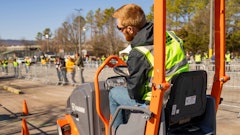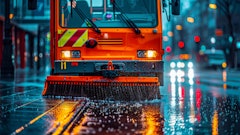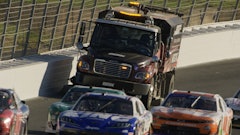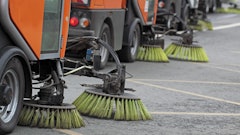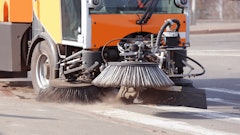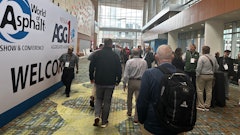
Safety remains essential to every contractor, employee and jobsite. While there are standard safety procedures to follow, contractors should always keep an eye open for additional ways to keep their crews safe. As sweeping equipment continues to evolve to become more productive, additional features are also being designed to improve the safety of the crew and the traveling public.
While a properly trained sweeper operator is still the best bet for safe operation, new designs and upgrades to sweeping equipment can help improve the odds.
Design Matters
A sweeper that’s designed to adequately handle loads without tipping or roll-over, while rare, is paramount when teamed with a safe operator. Visibility around the entire machine and the ability to adequately see the traveling public while driving is also important.
“Line of sight to the road surface in front and side to side are critical to the safety of the citizens during sweeping,” Chad Bormann with Global Environmental Products says. “Sweeper design should provide the best line of sight with the cab over chassis designs as well as center cab steering positions.”
Smaller design elements can also help improve safety during operation.
"We look at the simple things on the sweeper to make sure safety comes first," Tom Rokas with Tymco says. "Take for instance the grab handles and steps. We position them to make sure there is an easy way for the operator or service technician to maneuver his way around the sweeper. We offer several grab handles within reach of the steps so regardless of the height of the person needing to access the sweeper, that person can have a 3 point accessibility to the auxiliary engine area. The grab handles are positioned far enough out so that a person wearing work gloves can put a hand around it.
"In addition, we also place work platforms with non-skid grates, so operators and service technicians have a place to stand when working on and around the auxiliary engine that slip-resistant. Extra care is taken in the metal fabrication of the sweeper body and engine cowling to reduce sharp edges. By reducing sharp edges we not only reduce safety hazards, but also helped operators and service technicians avoid getting scratched up while working on the machines."
Watch Every Move
Cameras are also becoming standard on sweeping equipment as well to improve safety.
“Sweeper operators have an incredible amount of things going on that need constant observation, and because a sweeper has no natural rear viewing capability, a rearview camera is a must,” Greg Heyer with Schwarze Industries says. “An on-board camera system also allows the operator to see equipment such as the brooms and other equipment without looking away from the windshield. These cameras can include audible object detection and zone warning as well. This allows the operator to look immediately at the camera when warned.”
"Rearview and side mirrors are important, but they don’t provide complete visibility," says James Crockett, sweeper products manager, Elgin Sweeper. "A rearview camera helps to eliminate rear blind spots and provides greater visibility to the rear of the sweeper, reducing the risk of injury and equipment or property damage."
“Rear view cameras can be used functionally during sweeping to see if adjustments need to be made to improve sweeping and are also the safest way to see traffic behind without taking your attention away from what is happening in the front,” Bormann adds.
However, cameras can also a safety hazard if not utilized properly says David Dubbioso of Tri-State Equipment Rebuilding Inc of Oxford, CT.
"Drivers tend to rely on them and not use their mirrors to view the sides of the machine," he says. "If cameras are used for monitoring sweeping and looking at gutter brooms, the in-cab camera screen needs to be mounted forward facing (not in headliners and control pods) so the driver does not have to take their eyes off the road."
Crockett adds that it's also important for rearview camera to be cleaned regularly to ensure the field of view is not obstructed.
Heyer also says cameras are being developed that can record the images on the screen. This system is similar to an aircraft “black box” that records what happens to and around the sweeper as it performed its sweeping route. Recordings can be helpful to improve liability in the event an accident does occur.
Bells & Whistles Improve Safety
While lights and alarms may not seem as important as hopper capacity when purchasing a sweeper, they are critical to safety.
“Ample conspicuous lighting is probably the most important safety feature on a sweeper,” Heyer says. “Vehicles rear ending sweepers is one of the most common collisions experienced in the industry, sweepers simply cannot have too much lighting.”
Manufacturers agree that LED lighting is proven to be the brightest and most efficient option for lights on the sweeper.
New LED technology has allowed much more lighting options due to increased brightness and lower current consumption. This means that older systems can be upgraded easily without adding additional wiring. This new technology also allows light pattern programming at each lamp assembly.
Because many sweeping shifts are so long and at night, alarms that monitor the driver’s position to detect the operator dozing off can be very beneficial in preventing going to sleep at the wheel incidents.
However, manufacturers are careful with the use of lighting.
"At night, the work lights should be bright but not blinding to the other drivers approaching the sweeper, but letting them know that there is a hazard area close by," Dubbioso says."Municipalities are getting away from the use of arrow boards and flashing directional sticks. They are becoming a liability because there are too many vehicles being directed into oncoming traffic."
Alarms are also being improved to better alert pedestrians during sweeping. Dubbioso strongly recommends backup alarms become standards on sweepers as they can be used during dumping to make people aware of the hazard and also alert the dump truck driver that dumping is still in operation.
“For pedestrian protection, a backup alarm is a must,” Heyer says. “With all the things a sweeper operator needs to keep watching, pedestrians need to be warned when in the proximity of the sweeper.”
While the cost to upgrade your equipment may be a determining factor holding contractors back, the cost of preventing an accident and saving a life is priceless.
However, the equipment can only do so much. Sweeper operators and technicians should always follow the manufacturer’s procedures for proper and safe daily inspection, cleaning and servicing of the machine.
Street sweepers are only as safe as their operator. If a driver is distracted or uneducated on the machine, it can be a major safety hazard. Not only should the operator be properly trained, they must also be alert of their surroundings at all times to maintain a safe environment.



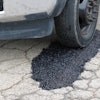
![Pavement Awards 2025[main]](https://img.forconstructionpros.com/files/base/acbm/fcp/image/2024/05/PavementAwards_2025_main_.665883e4276e8.png?auto=format%2Ccompress&bg=fff&fill-color=fff&fit=fill&h=100&q=70&w=100)








![Pavement Awards 2025[main]](https://img.forconstructionpros.com/files/base/acbm/fcp/image/2024/05/PavementAwards_2025_main_.665883e4276e8.png?ar=16%3A9&auto=format%2Ccompress&bg=fff&fill-color=fff&fit=fill&h=135&q=70&w=240)
